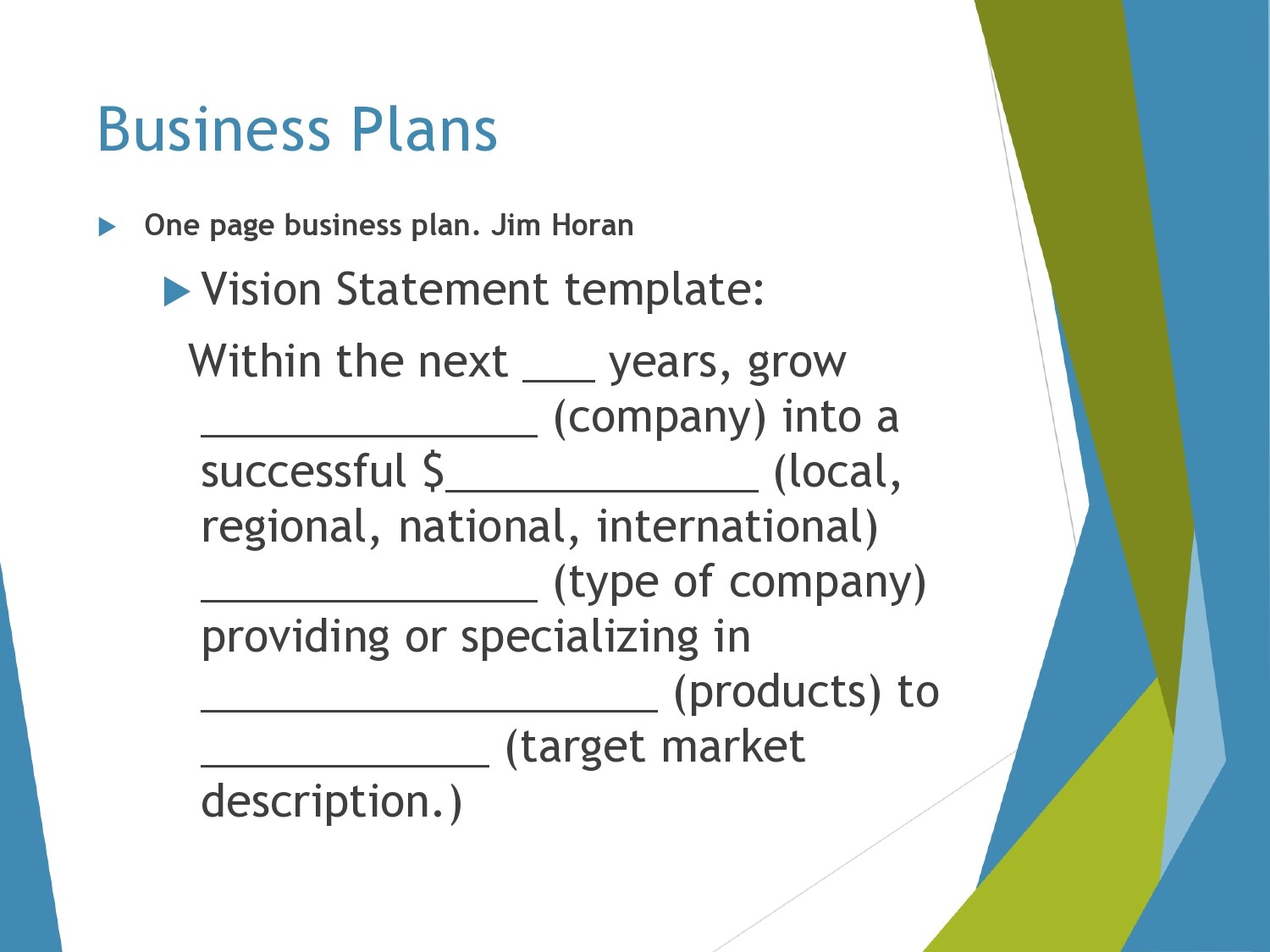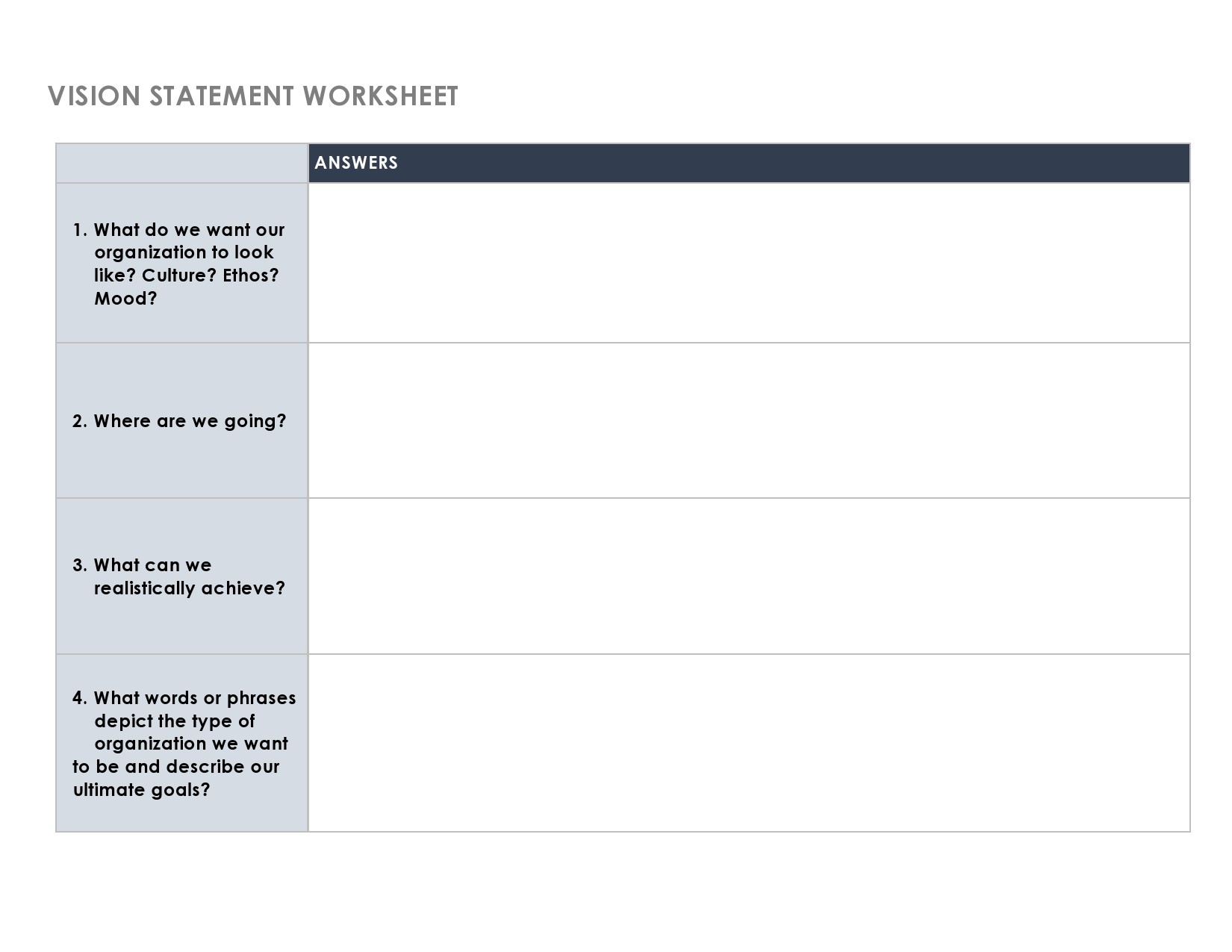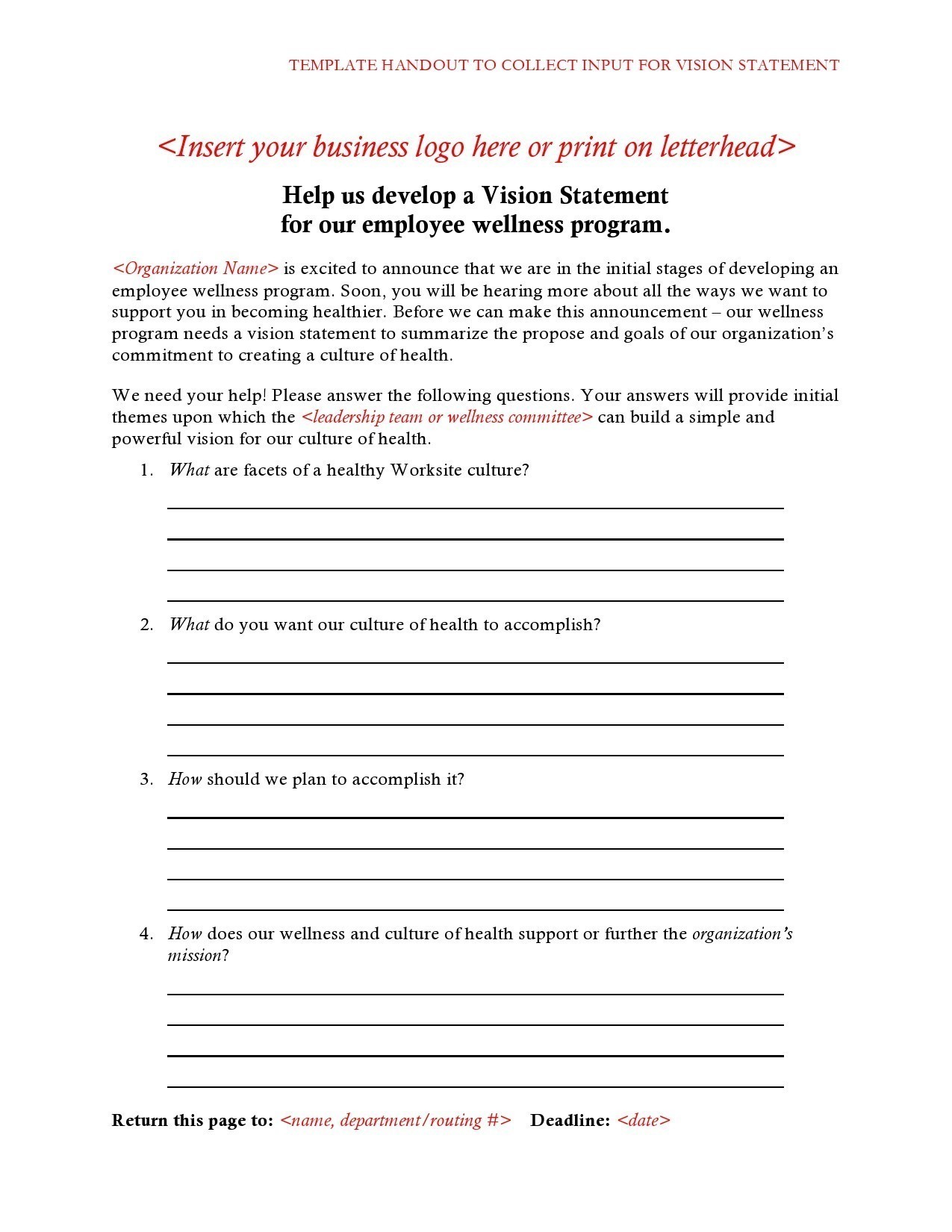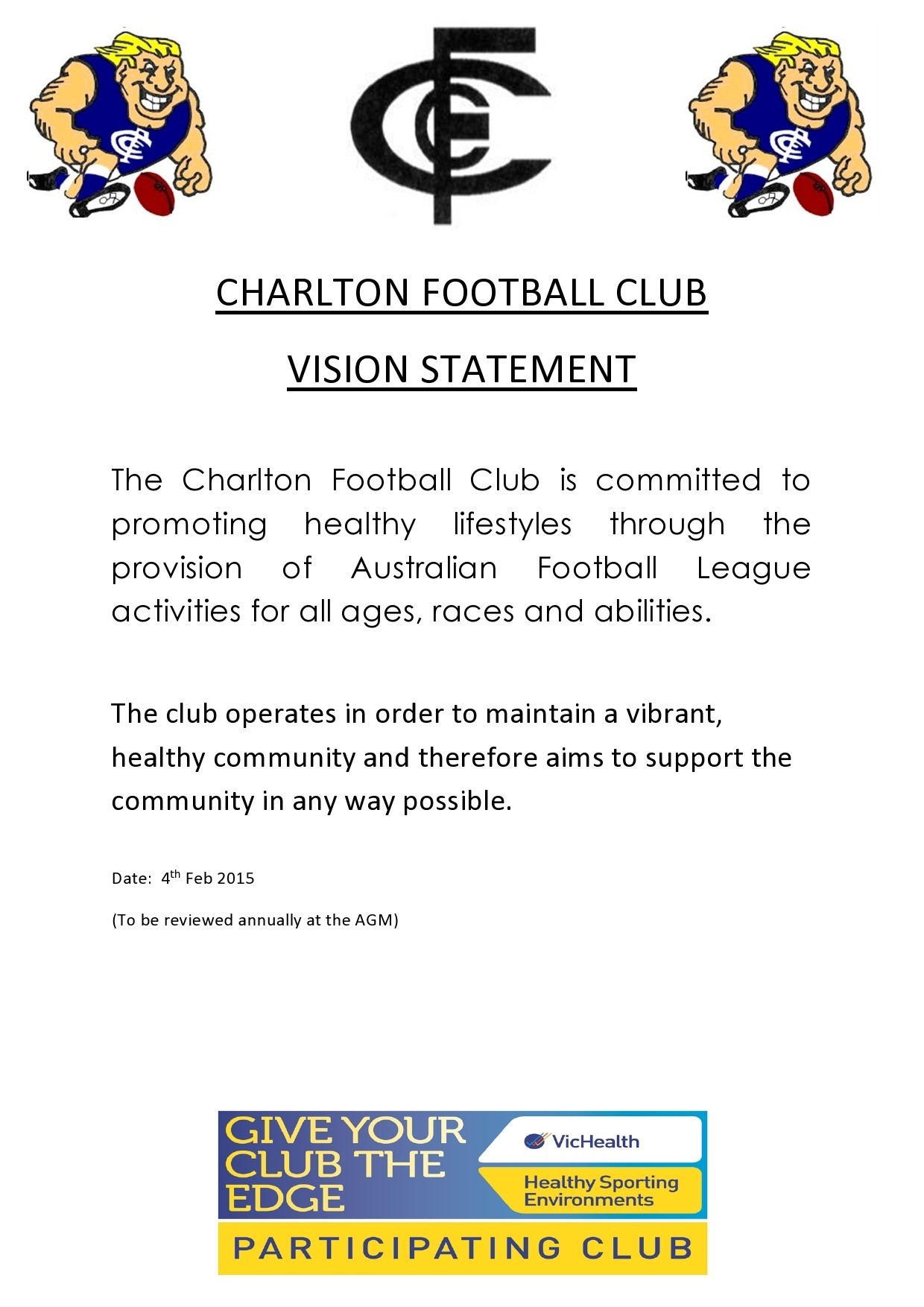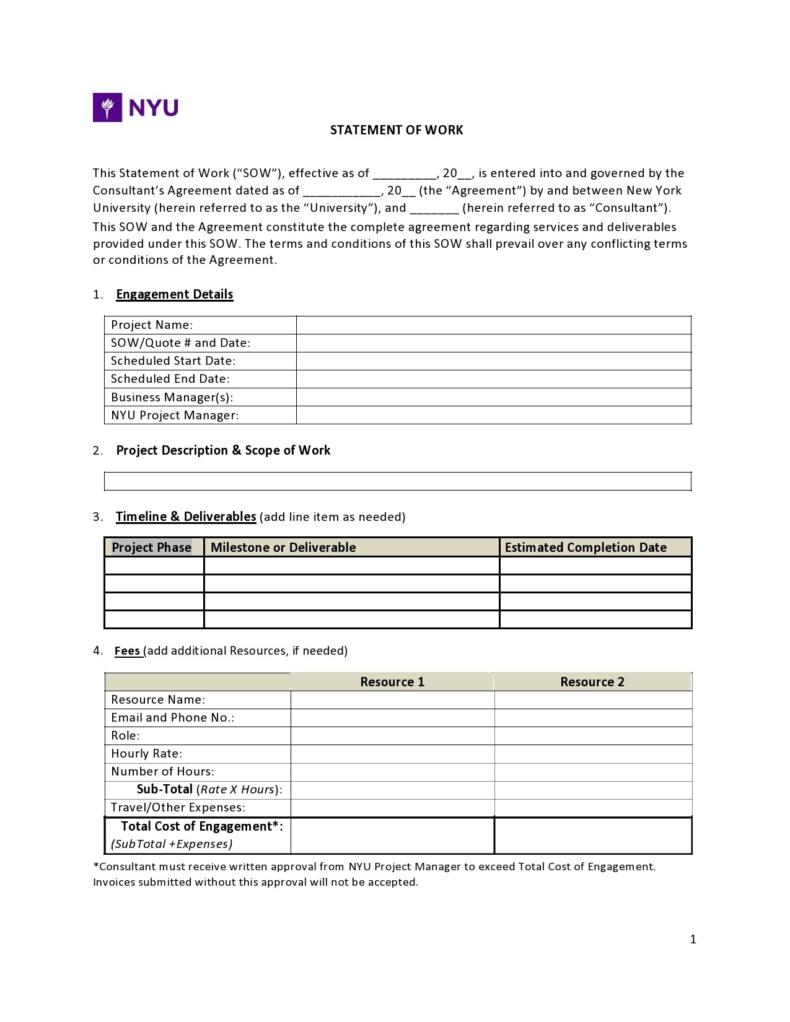A company’s vision statement is short but it is one of the hardest to write. Even the most experienced entrepreneurs daunt writing a vision statement for their business. It defines the company and its future. By reading the vision statement, a person should instantly understand where the company is coming from and where it is heading to. The vision statement template helps business owners to write their vision statement with ease.
Table of Contents
- 1 Vision Statement Templates
- 2 What is a vision statement?
- 3 Vision Statement Examples
- 4 The main difference between a vision and a mission statement
- 5 How do you write a vision statement?
- 6 Company Vision Statements
- 7 What’s a good vision statement?
- 8 What is an example of a vision statement?
- 9 Strategic Vision Statements
- 10 Main types of vision statements
Vision Statement Templates
What is a vision statement?
Company management should describe their business ambitions. They should state what they want to achieve and how they will achieve it. The company vision statement contains summarized information about its goals.
It defines where the company is headed to. The statement also outlines the core values guiding the business and its long-term objectives. Strategic vision statements are usually short and are strategically displayed in the business for everyone to see. It inspires employees and employers to focus ahead towards the goal.
Vision Statement Examples
The main difference between a vision and a mission statement
A vision statement gives focus on where a business is headed to. It states what the company desires to become. A mission statement focuses on the now. It states what the company is doing today to help it achieve its end goals.
A business needs to have both a vision and a mission statement. Both statements serve the same goal. The mission statement serves the short-term goal, while the vision statement serves the long-term goal.
Questions a vision statement should answer
For strategic vision statements to be complete, business owners must answer three main questions correctly.
What are your business hopes and dreams?
Every individual has something they hope for. They have a dream they are pursuing. These are things that you would like to see come to pass in your life. The size of your dream determines the results you will get.
When they are starting a business, many entrepreneurs transfer their hopes and dreams into the business. They become the business goals and they start working harder towards them. When the business is owned by several people, each person comes with their hopes and dreams and the partners mutually agree on a shared vision.
This is what sets the business on a journey towards its future. Many other activities happen in between to help the business get into its future. The business person must make several choices to help them overcome the hindrances.
They must:
- Choose what is important to the business and ignore the rest
- Choose the daily activities that will culminate into the vision
- Work with the right people that will support the business goals
- Choose the right location to launch the vision
- Learn new things in different ways
- Commit themselves to work towards the vision
- Be part of a bigger community of customers, suppliers, workers, and partners to fulfill the goal
What type of problem are you solving for the greater good?
Every business focuses on solving a specific problem. The business person identifies a gap in the market and seeks to fill it. As they do so, they get a profit for the service. For example, the person who created a telephone was filling a communication gap for people who are far apart.
The company vision statement must state the type of problem/gap the business is filling. The most important question you should ask yourself is whether you are solving the right problem. If the company is solving the wrong problem, it cannot go far.
If it’s solving the right problem, ask yourself how well it’s solving it. It could be solving it at 40%, 60%, 80%, or even at 100%. How well you are solving the problem will determine has to fast your business will fulfill its vision.
To solve the problem amicably, the business owner must take several actions:
- Seek to leave a legacy
- Be willing to work with outsiders
- Let people help him redefine the vision
- Find the missing gaps in the business vision
- Create effective winning strategies
Who and what are you inspiring to change?
Strategic vision statements are written by business owners but their fulfillment is done through customers. The vision statement should inspire the owners first, then the team they are working with, and eventually the customer they are serving.
If one party is left without inspiration, the company will lag in its vision. The business person is inspired to invest in everything required to make it happen. The worker is inspired to make the company better by doing what is right. The customer is inspired by the worthiness of the business products and they buy them.
To make it happen, the business person must take several steps:
- Make the inspiration bold
- Connect it to something bigger
- Create change
- Listen to workers, customers, suppliers, and understand
- Source for the inspiration
How do you write a vision statement?
Every company has a unique company vision statement. When designing a vision statement, it may help to refer to several vision statements examples for inspiration. The wording used by each company is different but the process is similar. These are the steps to follow.
Define the business core values
A business’s core values define the deep-rooted principles that guide it to success. They are what create a conducive business culture. The core values must be inherent and hard to compromise. Some core values can be short-term, while others can be long-term. They define a business identity and its interactions with society.
Refer to your company mission statement
Strategic vision statements are built upon strong mission statements. The little things a business person does daily climax to the fundamental goal. A strong mission statement will have the following details:
- The vision statement must define the products or services the business is selling
- A good statement must define the market segment the business is serving
- It describes the technology it’s implementing to achieve the short-term goals
- It should include the business values. This is the business philosophy
- A clear vision statement must indicates employee policies
- Its survival plan for growth/profitability
These are the details that should guide you when writing your business vision statement. They all culminate into the broader goal defined in the vision statement. You may refer to team vision statement examples for better ideas.
Define your business culture
Business culture can be defined as the behaviors and procedures observed by a company in its operations. Everything contained within the business operations, such as employee conducts, their attitude, the business ethics, procedures, values, and goals. These are some of the things that will be noticeable in any vision statement examples.
Give focus to the current strategic objectives
Most businesses create short-term and long-term strategic objectives. Short terms goals could be annual, while longer-term could go up to five years. The company vision statement must align with the current strategic goals.
Write your future goals
From the current objectives, look further into how you want the company to be in the future. You can think about things such as:
- Adding new products
- Investing in business tools
- Hiring more workers
- Reduction of waste
- Winning new markets
- Increasing productivity
Write the company vision statement
Having prepared these details, it will be time to write your business vision statement. Refer to team vision statement examples to help you follow the best practice for writing strategic vision statements.
Company Vision Statements
What’s a good vision statement?
Every good company vision statement focuses on the future but is written in the present tense. In other words, the business person writes it as though they are already in the future yet in the present.
Even after the business achieves the vision, it doesn’t stop at that level because it’s both present and future. Whatever the business person does, hears, or imagines is all geared to the final goal. This is what a good vision statement should have:
It should be a summary
A mission statement can be lengthy but a vision statement should be short. Most vision statements are one-liners, although some might have two or three lines. The first few words in the vision statement contain the core message.
It should be a strategic message that can be replicated everywhere the brand goes. The vision statement is different from a brand tagline but it must communicate the vision easily.
It must define expected outcomes
If you read the business goals, mission, and values, they should all be captured in the vision statement. The outcomes are not defined numerically. It is all about the expected end, which is hope to be great. The team vision statement examples will give you an idea.
It is concise
A company vision statement should be easy to read. You should avoid giving too many details. When someone reads the statement, they should be able to memorize it with ease and run with it.
It must be clear
Clarity means focusing on the main goal. You should avoid using filler words that scatter the main ideas. State the final goal directly using the fewest words possible. It is better to have one clear goal instead of having several confusing ideas.
It must have a definite time
A vision statement is never indefinite. It should have a clear future time. This is the time when you expect to reach your final goal. Having a defined time helps you to focus all energies towards that time. After reaching your goal, you can set a new vision with another timeline.
It must be inspiring
The vision must inspire everyone involved in driving the company into it. When they read it, it should create a desire to act.
It must be challenging
To be challenging means you don’t set goals that are too easy for anyone to achieve. Instead, you should set goals that are achievable but not easily. It will give reason to take bold steps daily to achieve it.
Make it future-oriented and stable
Although the vision statement is written in the present, its focus is on the future. Every step taken daily is a success in the future. To be stable means the vision cannot be affected by what happens in between. Sometimes there could be sharp market fluctuations or new technologies might come. No matter what happens, your business vision should remain stable.
What is an example of a vision statement?
When you are starting a business, you will mostly have a general idea of what you want to achieve. You can explain to someone the kind of success you are looking forward to. These are the ideas that you will write to create a concrete, definite path. To write your ideas helps give clarity to your thoughts. It helps your employees to understand your expectations. It is what motivates them to push on.
There are different types of team vision statement examples you can get online. The most important thing is to download a vision statement template to make your work easier. The vision statement examples will only help you get better ideas but the template will help you capture the most precise information.
Write the statement in a first-person perspective. You will focus on plural words such as our, we, us. If you are offering fast food service, you can use the words such as “our vision is to offer quick service…” in the first line.
In the next line, you can write the values that you will honor to help you offer that service. You can use words such as quality, value, cleanliness, etc. The final line should define the experience the customers will get. You can use the words such as smile, satisfaction, fast, friendly. Three lines of a vision statement will be enough.
Strategic Vision Statements
Main types of vision statements
There are two main types of vision statements.
Superlative
These are the types of vision statements that focus on the company being top, leading, number one, best, etc. It is written in superlative adjectives. Most for-profit-oriented companies write these types of vision statements.
Quantitative
These are the types of statements that include numbers. It can use words such as “where everyone is included,” “every child gets protected,” “incorporate more people,” etc. The company or organization aims to achieve quantities. Most NGOs or nonprofit organizations write these types of vision statements.








